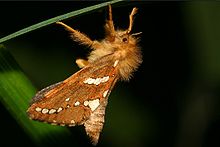The Hepialoidea are the superfamily of "ghost moths" and "swift moths".[1]
| Hepialoidea | |
|---|---|

| |
| Phymatopus hecta | |
| Scientific classification | |
| Domain: | Eukaryota |
| Kingdom: | Animalia |
| Phylum: | Arthropoda |
| Class: | Insecta |
| Order: | Lepidoptera |
| Infraorder: | Exoporia |
| Superfamily: | Hepialoidea Stephens, 1829 |
| Families | |
| Diversity | |
| 67 genera and at least 617 species | |
Fossils
editFossil Hepialoidea appear to be few.[2] Prohepialus (possibly Hepialidae) has been described from the about 35-million-year-old Bembridge marls of Isle of Wight.[3] A mid-Miocene hepialoid fossil is also known from China.[4]
References
edit- ^ Kristensen, N. P. (1999). The homoneurous Glossata. pp. 51–63 In: Kristensen, N.P. (ed.), Lepidoptera, Moths and Butterflies, 1: Evolution, Systematics, and Biogeography. Handbook of Zoology, volume 4 (35). Walter de Gruyter. Berlin, New York.
- ^ Kristensen, N. P. and Skalski, A.W. (1999). Phylogeny and paleontology. Pages 7-25 in: Lepidoptera: Moths and Butterflies. 1. Evolution, Systematics, and Biogeography. Handbook of Zoology Vol. IV, Part 35. N. P. Kristensen, ed. De Gruyter, Berlin and New York
- ^ Jarzembowski, E.A. (1980). Fossil, insects from the Bembridge Marls, Palaeogene of the Isle of Wight, southern England. Bulletin of the British Museum (Natural History) (Geology), 33: 237-293.
- ^ Zhang, J. (1989). Fossil insects from Shanwung, Shandong, China. Shandong Science and Technology Publishing House.
External links
edit- Tree of Life Archived 2007-09-30 at the Wayback Machine
- Hepialidae of the World - List of Genera and Links to Species
- Common Name Index